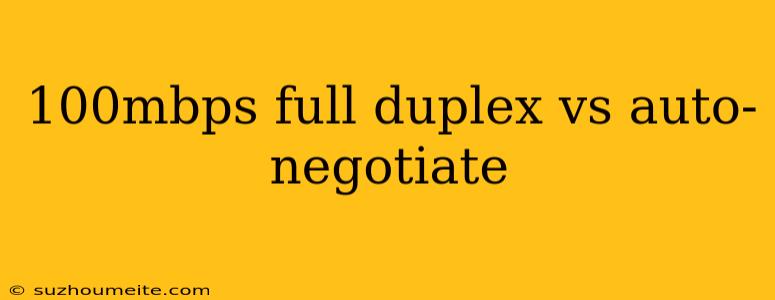100Mbps Full Duplex vs Auto-Negotiate: What's the Difference?
When setting up a network connection, you may have come across two terms: 100Mbps Full Duplex and Auto-Negotiate. Both options are related to the speed and duplex mode of your Ethernet connection, but they serve different purposes. In this article, we'll explore the differences between 100Mbps Full Duplex and Auto-Negotiate to help you make an informed decision for your network setup.
What is 100Mbps Full Duplex?
100Mbps Full Duplex is a specific Ethernet speed and duplex mode setting. In this mode, the network connection operates at a speed of 100 megabits per second (Mbps) and uses full-duplex transmission. Full-duplex transmission allows the network interface to transmit and receive data simultaneously, without interruptions. This increases the overall throughput and reduces latency.
Advantages of 100Mbps Full Duplex:
- Higher speed: 100Mbps is a relatively fast speed, suitable for most networking applications.
- Less latency: Full-duplex transmission reduces latency, making it suitable for real-time applications like video conferencing or online gaming.
What is Auto-Negotiate?
Auto-Negotiate is a feature that allows a network interface to automatically detect and configure the optimal speed and duplex mode for a connection. When set to Auto-Negotiate, the network interface communicates with the connected device to determine the highest common speed and duplex mode supported by both devices.
Advantages of Auto-Negotiate:
- Flexibility: Auto-Negotiate allows the network interface to adapt to different network environments and devices.
- Ease of use: You don't need to manually configure the speed and duplex mode, as the interface does it automatically.
Key Differences:
Speed and Duplex Mode: 100Mbps Full Duplex is a fixed speed and duplex mode, while Auto-Negotiate is a dynamic setting that adapts to the connected device.
Manual vs. Automatic Configuration: 100Mbps Full Duplex requires manual configuration, whereas Auto-Negotiate automatically detects and configures the optimal settings.
Compatibility: 100Mbps Full Duplex may not be compatible with all devices or network environments, while Auto-Negotiate is more flexible and adaptable.
When to Use Each?
Use 100Mbps Full Duplex:
- When you have a specific requirement for a 100Mbps connection.
- When you need to ensure a stable and high-speed connection for a specific application.
- When you're using a device that only supports 100Mbps Full Duplex.
Use Auto-Negotiate:
- When you're unsure about the optimal speed and duplex mode for a connection.
- When you need to connect to a device with an unknown or variable speed and duplex mode.
- When you want to ensure compatibility with a wide range of devices and network environments.
In conclusion, 100Mbps Full Duplex and Auto-Negotiate are two different approaches to configuring your network connection. While 100Mbps Full Duplex offers a fixed speed and duplex mode, Auto-Negotiate provides flexibility and adaptability. Choose the one that best fits your networking needs.
